The type of journey you intend to take will determine your kayak paddle length and width. Additionally, paddles come in various materials like carbon fiber blades and fiberglass blades. Each material has advantages and disadvantages of its own, so it’s crucial to select one that will meet your demands for kayaking.
When it comes to paddles of kayak, this is only a very condensed talk because you need to pay attention to several factors and take accurate measurements in order to have the greatest equipment for your adventurous demands.
In fact, you can have the fastest kayak in the world, but if you don’t choose the right paddles, you will not go anywhere.
Why Does the Size of Kayak Paddle Matters?
Kayak paddles are essential because they will determine how fast you will go and how comfortable you will feel during your chosen extreme sport. But let me explain in a more practical way, so you can understand the importance of this gear piece.
The size of your kayak paddles depends on your kayak’s width. Generally, the wider and higher you are, the bigger your paddle needs to be.
For instance: if you’re 5 feet tall and paddling in a 12-foot wide kayak, then a paddle that is 4 feet long should be just right for you. A 6-foot-tall person would need a 5-foot long paddle, while someone who is 6 feet 3 inches would require a 6 foot-4-inch long one.
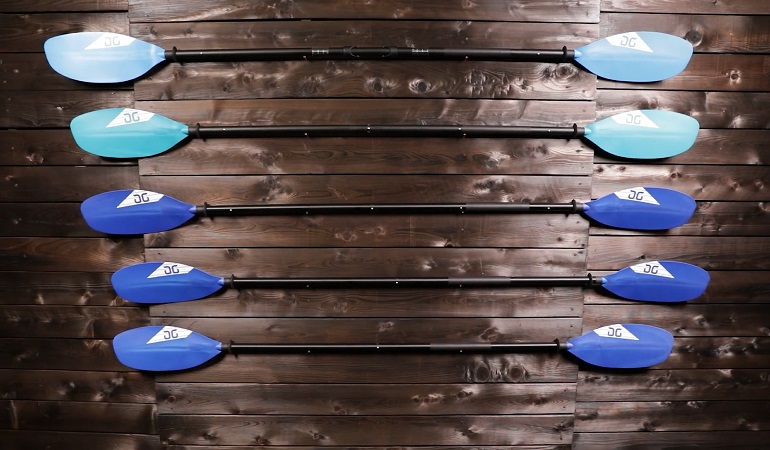
Similarly, longer boats will generally require long-length paddles than their shorter counterparts because they generate more power when used properly by skilled kayakers with better technique (and lower centers of gravity).
Now, if you’re a beginner and don’t have much experience with water sports in general, then you may want to get a shorter paddle as it will be easier for you to learn how to use one.
However, once you get better at kayaking and more skilled at using your paddle effectively, then you should definitely consider upgrading your equipment.
How to Size a Kayak Paddle?
The best way to size kayak paddle length is by trial and error. This is because each kayaker has their own unique body type, so it’s difficult to make one-size-fits-all recommendations. However, there are some guidelines that can help you choose the right paddle sizes.
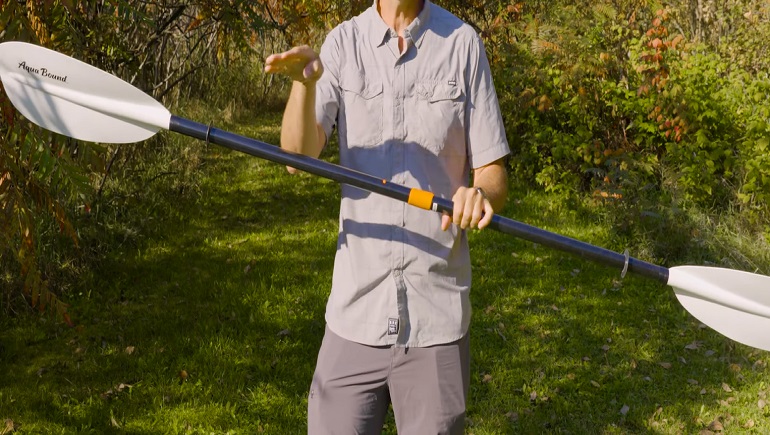
Measure the Kayak Width
The correct length of your perfect paddle depends on a few factors. The first and most important is boat width. The wider your kayak, then the bigger your paddle needs to be in order to allow for proper power and efficiency when paddling.
In order to measure your kayak width, use a tape measure to determine the total distance from the port (left) side to the starboard (right) side at the widest point on your boat.
Measure Torso Height
The first thing to measure when paddle sizing is your torso height. This is the distance from the spine at the base of your neck to your lumbar section. Ideally, the best paddle length should be about 6 to 10 inches shorter than your upper body height for optimal control and maneuverability.
Measure your Body Height
The goal here is to find how tall you are, but this number can vary based on how high or low you stand when you paddle normally. Some people tend to stand more upright for stability and control, while others prefer a more laid-back position for better speed and efficiency.
Also, taller people should use longer paddles; shorter people should use shorter ones. In general, longer paddles allow for greater power than shorter ones do, but they also require more energy from the user because they weigh more (this isn’t as much of an issue if you have strong shoulders).
If you’re unsure which way best suits your preferences, try both options before making a final decision.
The following kayak paddle sizing guide chart illustrates how to determine which paddle length is best for you. This is a general kayak paddle sizing guide; please take into account your own personal preferences when making your decision and let the kayak paddle size chart come second.
The most important thing to keep in mind when sizing up your new favorite piece of equipment is how strong and comfortable your grip will be while holding onto it! If there’s too much room between where your hand stays around the grip, then this could result in discomfort over time.
What Paddle Category Is Right for Me?
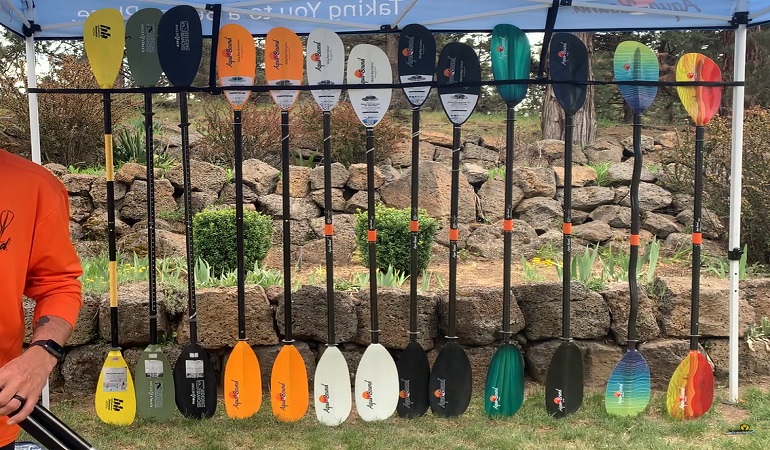
The paddle types you choose should depend on how often you kayak and what paddling style you prefer.
For example, if you are a beginner or like casual paddling pace, someone who tends to go out on calm lakes and rivers, then an all-around paddle is probably best for you. This type of paddle has a medium weight, size, and blade angle that will work well in most situations.
But let’s be more precise, so you can understand better what category fits you best.
Recreational Paddles
Recreational kayak paddles are great for beginners and those who are just looking to have fun on the water. If you’re new to kayaking, this is the best paddle type for you.
Whitewater paddles
Whitewater paddles are designed for flat-water paddling but can also be used in low rivers. These kayak paddles have a scooped blade shape that makes zig-zagging easier through rapids without getting stuck or flipped over by the current.So, if you plan on whitewater kayaking or racing your boat down rapids and waves, then you’ll need an open-blade paddle with more aggressive blades and more power to help you navigate rapid waters.Open-blade kayak paddles have larger blades than recreational paddles; this helps create more power when paddling through rough waters and cold weather.
Touring Paddles
Touring paddles are ideal for long-distance trips. This is a longer paddle than recreational models and offers more power from each stroke due to its larger blades and higher-density shafts.Touring paddles usually come with a straight shaft. Like whitewater kayak paddles, they may also feature a T-grip bent shaft to give great precision control in flat water conditions when getting it right the first time is crucial or in heavy weather conditions where every stroke counts.The straight shaft paddle is more efficient than the bent shaft paddle as they allow the full power of your body weight and force to be applied directly onto the blade. This means that you don’t need to put as much energy into each stroke, allowing you to paddle for longer without tiring out too quickly.
How Do I Know What Blade Shape To Choose?
On the market, the most common types of paddle blade shapes are high-angle and low-angle paddling.
There are two main ways they differ: they catch more water at different angles, which changes the way you pull through the water with each stroke, and they vary in the length-by-width ratio (for example, true high-angle blades tend to be shorter and wider than lower angle).
While some manufacturers make their blades feather able (meaning they can be used both ways), some don’t have this option built into their design at all—so it’s important to know what kind of blade shape you want before making any purchases.
A good rule of thumb is to try a few different types of paddles before buying one.
High-angle
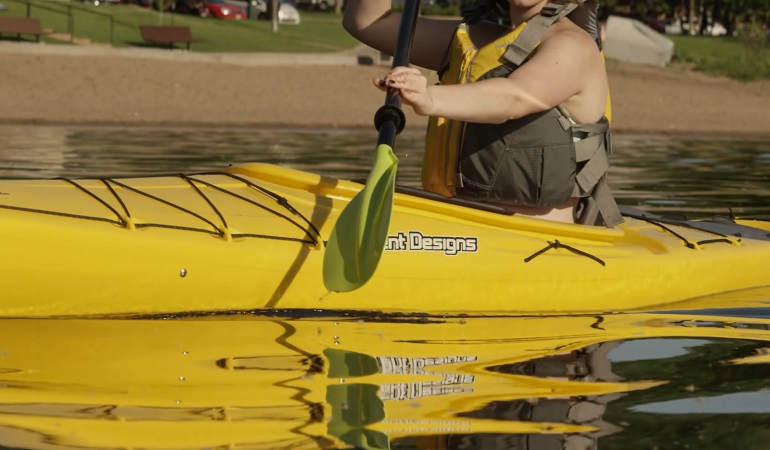
Wide and typically short, high-angle paddles are designed to be inserted into the water almost perpendicular to the water’s surface. They serve to steady a kayak or canoe with an abnormally narrow boat width in turbulent waters.
High-angle paddling blades are shorter and wider than low-angle ones; they have more surface area when moving through water—making them more efficient with less twist in your torso.
Low-angle
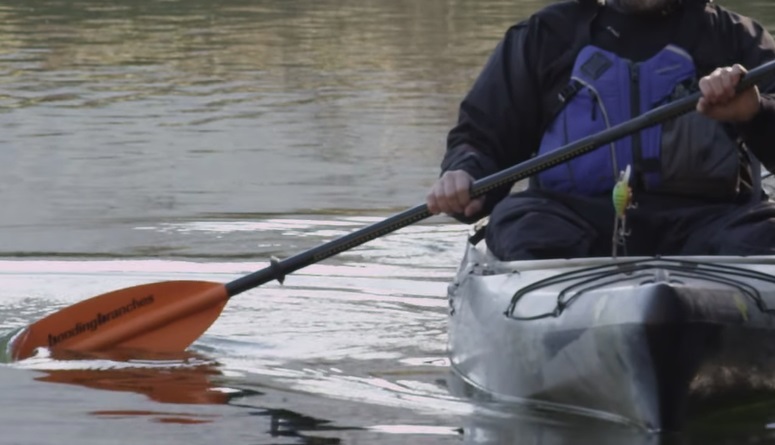
Low-angle paddling is made for powerful pulling and efficient power strokes. You may easily drag through the water by using low-angle paddling blades. Lower-angle blades are longer and narrower blades; they push against each other along their edges rather than just at their tips, making them more powerful per stroke.
The shape of your paddle blades, or the cross-section that makes up its profile, is not the only factor in determining the stroke efficiency of a true low-angle paddler. But it does play an important role.
If you’re new to paddling, don’t worry about choosing a high-angle or low-angle blade until after some time on the water and with an instructor. The most important thing is just to get out there and have fun. First, find your paddling style.
Feathered paddle
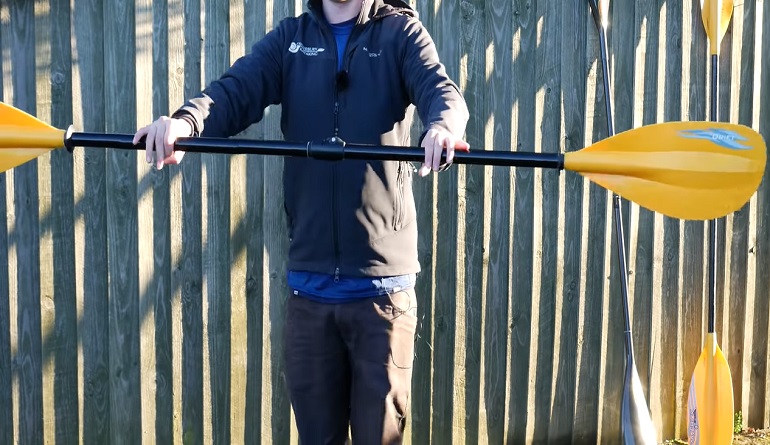
A feathered paddle blade improves its efficiency by keeping both paddle shafts at an even angle to each other at all times, but this requires a ferrule (the part that holds the two blades together) that can be adjusted for feathering.
Keep in mind that this may not make as much of a difference if you only go out on short trips or in mild conditions.
Feathering is useful when you want your kayak to track straight without turning—and it’s especially important when there are strong winds or white-capped waves on the water. In those cases, it can be very difficult to maintain proper paddling technique and keep the boat straight with regular paddle blades.
A feathered paddle will help you keep your boat heading forward while still allowing you to maneuver around obstacles and use your strength efficiently without losing speed or control over direction because of wind gusts or currents pulling against your movement.
Kayak Paddle Material and Design
The material and design of the kayak paddle are also important. The type of material used to make your kayak paddle will affect its mass and durability.
You’ll want to find a paddle that’s right for you not only in terms of size but also with regard to material and design. Materials such as fiberglass and graphite are typically more durable than aluminum or plastic, while carbon fiber is one of the most lightweight paddles option available on the market today.
There are many different types of kayak paddles, and each one has its own benefits. If you’re looking for a durable, lightweight option that will last you a long time, fiberglass blades are the best choice.
If you prefer an affordable paddle with more maneuverability than other materials, an aluminum paddle can make all the difference.
The type of design that suits you best depends on what kind of water you plan to be paddling in most often, whether you’re looking for quick turns or straight tracking. So keep this in mind also when choosing kayak paddles.
FAQs
What Is The Best Way To Paddle a Kayak?
To get the most out of your kayaking experience, it’s important to learn the proper technique and use the right kayak paddle for your body.
There is no best way to paddle a kayak because it all depends on the water you are in, the paddle blades’ shape, the paddle category, and so on. Before anything, try to have fun.
What Size Kayak Do I Need For My Height and Weight?
When trying to figure out what size kayak you need, it is important to determine your height and weight. Each kayak has a weight capacity or the most that it can support while remaining afloat, so make sure to look for an appropriate weight capacity.
Also, it is best if you try the kayak before buying because you need to make sure that you fit well.
Conclusion
The paddle length is something that can be a bit confusing, but it doesn’t have to be! By understanding the different parts of the paddle and how each part affects performance, you will be able to choose the right size for yourself or someone else.
Hopefully, this article will help you to make the right choice!
0 Comments